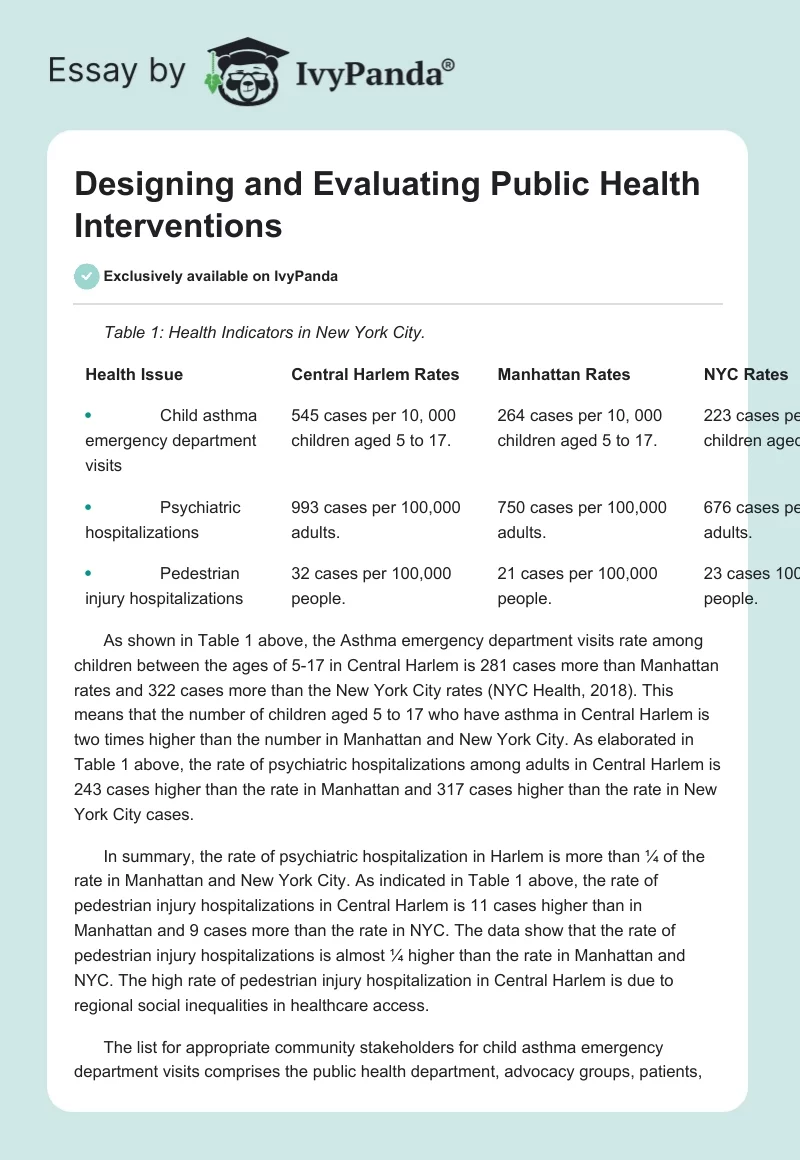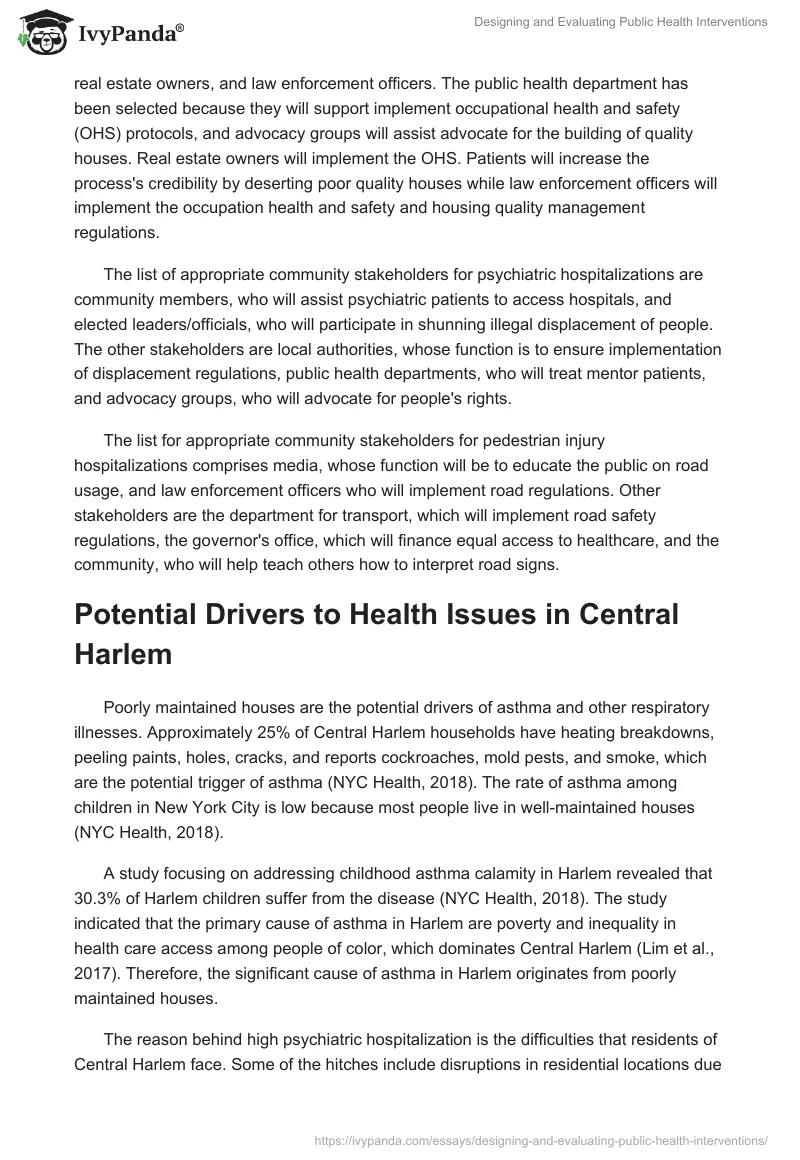Table 1: Health Indicators in New York City.
As shown in Table 1 above, the Asthma emergency department visits rate among children between the ages of 5-17 in Central Harlem is 281 cases more than Manhattan rates and 322 cases more than the New York City rates (NYC Health, 2018). This means that the number of children aged 5 to 17 who have asthma in Central Harlem is two times higher than the number in Manhattan and New York City. As elaborated in Table 1 above, the rate of psychiatric hospitalizations among adults in Central Harlem is 243 cases higher than the rate in Manhattan and 317 cases higher than the rate in New York City cases.
In summary, the rate of psychiatric hospitalization in Harlem is more than ¼ of the rate in Manhattan and New York City. As indicated in Table 1 above, the rate of pedestrian injury hospitalizations in Central Harlem is 11 cases higher than in Manhattan and 9 cases more than the rate in NYC. The data show that the rate of pedestrian injury hospitalizations is almost ¼ higher than the rate in Manhattan and NYC. The high rate of pedestrian injury hospitalization in Central Harlem is due to regional social inequalities in healthcare access.
The list for appropriate community stakeholders for child asthma emergency department visits comprises the public health department, advocacy groups, patients, real estate owners, and law enforcement officers. The public health department has been selected because they will support implement occupational health and safety (OHS) protocols, and advocacy groups will assist advocate for the building of quality houses. Real estate owners will implement the OHS. Patients will increase the process’s credibility by deserting poor quality houses while law enforcement officers will implement the occupation health and safety and housing quality management regulations.
The list of appropriate community stakeholders for psychiatric hospitalizations are community members, who will assist psychiatric patients to access hospitals, and elected leaders/officials, who will participate in shunning illegal displacement of people. The other stakeholders are local authorities, whose function is to ensure implementation of displacement regulations, public health departments, who will treat mentor patients, and advocacy groups, who will advocate for people’s rights.
The list for appropriate community stakeholders for pedestrian injury hospitalizations comprises media, whose function will be to educate the public on road usage, and law enforcement officers who will implement road regulations. Other stakeholders are the department for transport, which will implement road safety regulations, the governor’s office, which will finance equal access to healthcare, and the community, who will help teach others how to interpret road signs.
Potential Drivers to Health Issues in Central Harlem
Poorly maintained houses are the potential drivers of asthma and other respiratory illnesses. Approximately 25% of Central Harlem households have heating breakdowns, peeling paints, holes, cracks, and reports cockroaches, mold pests, and smoke, which are the potential trigger of asthma (NYC Health, 2018). The rate of asthma among children in New York City is low because most people live in well-maintained houses (NYC Health, 2018).
A study focusing on addressing childhood asthma calamity in Harlem revealed that 30.3% of Harlem children suffer from the disease (NYC Health, 2018). The study indicated that the primary cause of asthma in Harlem are poverty and inequality in health care access among people of color, which dominates Central Harlem (Lim et al., 2017). Therefore, the significant cause of asthma in Harlem originates from poorly maintained houses.
The reason behind high psychiatric hospitalization is the difficulties that residents of Central Harlem face. Some of the hitches include disruptions in residential locations due to displacement, making access to preventive healthcare services complex (NYC Health, 2018). According to Lim et al. (2017), adults who lived in gentrifying places in NYC and were displaced to non-gentrifying deprived neighborhoods of Harlem experienced a higher frequency of hospitalization. Therefore, the reason for advanced psychiatric or mental health hospitalization was related to displacement, which made access to healthcare difficult.
The driving factor to the high pedestrian injury in Central Harlem is due to social inequalities. A study conducted on pedestrian injuries in the region found that most adults and children preferred walking to their schools or workstations (Lim et al., 2017). The study indicates that most pedestrian injury hospitalization was among the aged and children who had no perceptual, cognitive, and behavioral abilities to negotiate traffic. The group suffered from injuries due to low vision or absent-mindedness while crossing the road. Therefore, the social inequalities in Central Harlem contributed to high pedestrian injury hospitalization.
References
Lim, S., Chan, P. Y., Walters, S., Culp, G., Huynh, M., & Gould, L. H. (2017). Impact of residential displacement on healthcare access and mental health among original residents of gentrifying neighborhoods in New York City. PloS ONE, 12(12), 1−12. Web.
NYC Health. (2018). Community health profiles 2018: Central Harlem. Web.


